Google Chromecast Review - An Awesome $35 HDMI Dongle
by Brian Klug on July 29, 2013 9:45 PM EST- Posted in
- Smartphones
- Media Player
- Android
- Mobile
- HDMI
- Chrome
- Tablets
- Chromecast
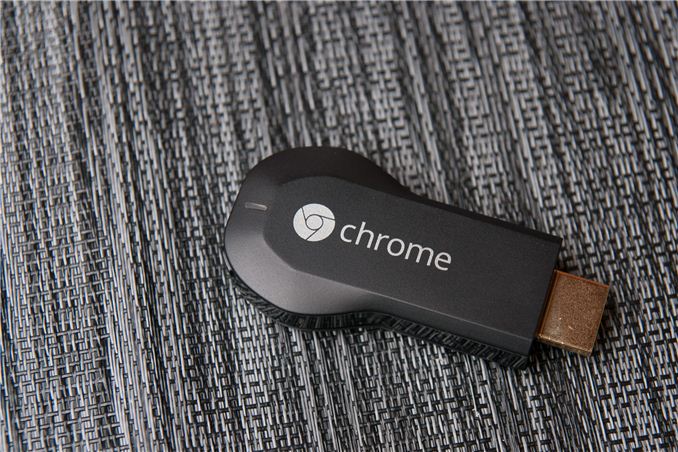
So I have a confession to make – I didn’t hate the Nexus Q. While I didn’t necessarily love it and use it daily like a small minority of my peers did, I also didn’t immediately declare the product an unmitigated disaster like the vast majority of people. The fate of that product was so quickly decided that I hadn’t even begun writing my review when the whole thing was terminated. When I spoke with Googlers about Nexus Q, what was obvious to me was that the Q had begun as an audio-only product that later on had HDMI added, and that tiny bit of context made all the difference in understanding the choices behind it. I left the Nexus Q plugged into my AV Receiver up until the most recent set of Google Play apps killed functionality entirely.
Ultimately the price of the Nexus Q was its undoing ($299), not necessarily its functionality or even its somewhat awkward spherical form factor. The concept was relatively sound – a network-attached appliance that played back movies and music from Google’s servers directly, rather than streaming them from device to device on the same network. The Q ran Android 4.x atop an OMAP4460, literally the same platform as the then-flagship Galaxy Nexus, just sans cellular connectivity, which made it a logical choice.
The Nexus Q was killed off before other services could be added, but at a high level the Q’s functionality as a playback device rather than streaming endpoint carried onto its successor, the Chromecast.
The Chromecast is obviously everything the Q should’ve been. It’s a simple, small, $35 HDMI dongle, powered by USB, that’s designed to discreetly plug into the back of a TV. There’s been much talk about the power requirement of the Chromecast, USB is indeed required for operation, but just about every modern TV has USB ports on the side for attaching mass storage or powering accessories like this. In fact, the Chromecast’s form factor is already a popular one for Android-powered HDMI dongles and Miracast sinks, as well as a variety of other small appliances. I’ve confirmed with Google that MHL-HDMI is not in fact supported by the Chromecast, meaning it can’t be powered by a TV that includes the spec (which can deliver up to 500 mA at 5 V), straight HDMI can only supply 50 mA at 5V. I’ve yet to encounter a TV with MHL-HDMI myself, including on the 55-inch LCD TV I purchased just 3 months ago.
Inside the box for the Chromecast is the device itself, a relatively long microUSB cable, USB power supply, and HDMI extender. Funnily enough the USB power supply appears to be the exact same as the previous generation Motorola USB charger (5V, 850 mA), just with a different exterior – is this the first Motorola product out of Google proper?
The HDMI extender cable helps get the Chromecast behind a TV if you need to turn it 90 degrees or have an inset port with inadequate clearance like I do on my front-facing HDMI accessory port.
There’s not much to talk about regarding aesthetics of the Chromecast itself, it’s a dongle with a rounded bulge at one end, and HDMI port at the other. There’s a reset button on the side, microUSB port for power, and a status LED on top. On the bottom are regulatory markings. My only complaint about the Chromecast’s design is this status LED, which inexplicably is bright solid white whenever the device is on, making it distracting in a dark living room or bedroom. Nothing electrical tape can’t solve, but an inexplicably poor choice for a media center playback device given that bright LEDs are a known no-no.
The hardware is what it needs to be – small, simple, and conducive to the low price point. The Nexus Q was a solid bowling ball in comparison, primarily thanks to the analog audio amplifier and hardware it really didn’t need. By keeping unnecessary I/O to a minimum the Chromecast ends up being a nice and small streaming appliance.


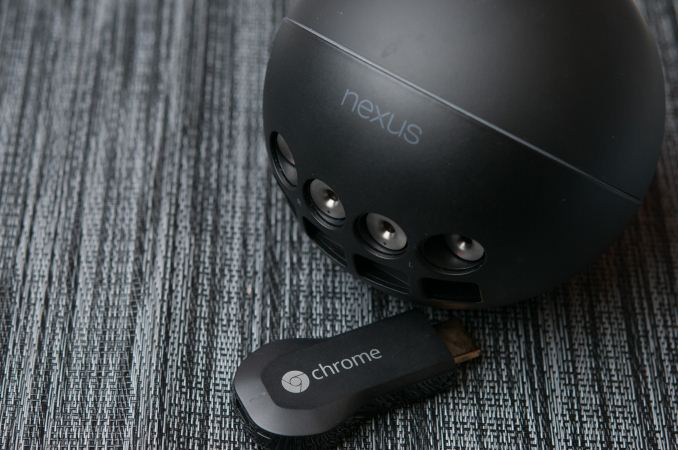
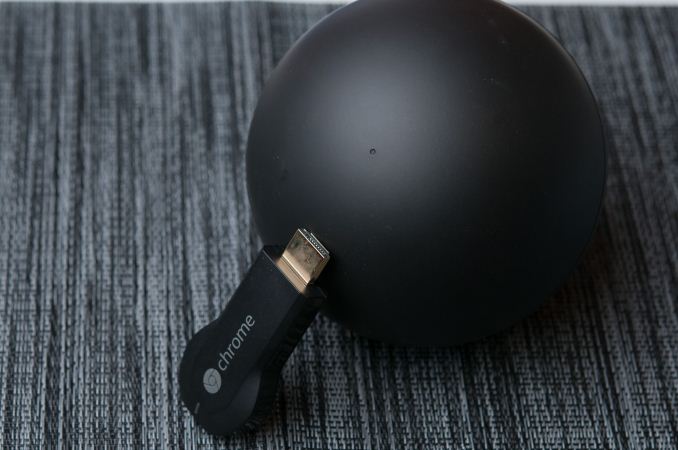

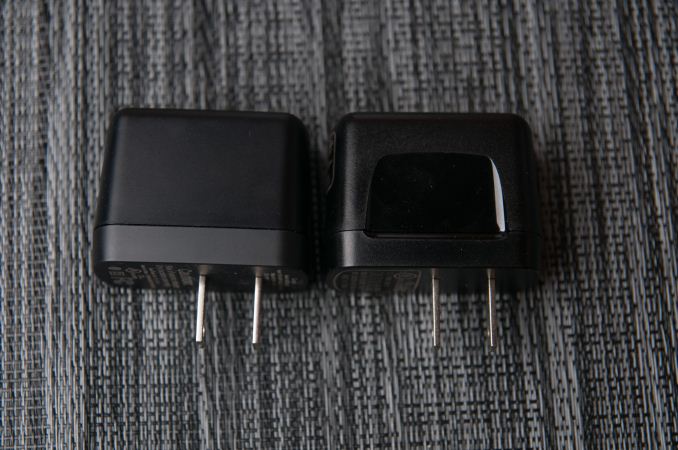






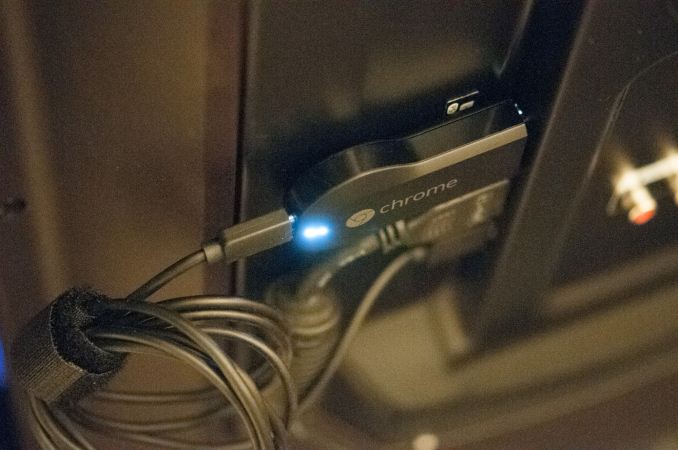








105 Comments
View All Comments
Brian Klug - Tuesday, July 30, 2013 - link
Roku removed 5 GHz then added it back after they realized what a colossal mistake that was, and costs considerably more than $35.-Brian
Alketi - Tuesday, July 30, 2013 - link
Anyone pick up on the model number Easter eggs?Chrome cast model #: H2G2-42
Power plug model #: MST3K-US
Gotta love Google. :)
shwetshkla - Wednesday, July 31, 2013 - link
plz explain.. :/cbrownx88 - Wednesday, July 31, 2013 - link
yes please do explain!critical_ - Wednesday, July 31, 2013 - link
H2G2 = HitchHikers Guide to the Galaxy42 = Answer to the Ultimate Question of Life, the Universe, and Everything in H2G2
MST3K = Mystery Science Theater 3000
r3loaded - Tuesday, July 30, 2013 - link
Chromecast looks nice, but I'm not sure why everyone's raving about it. For me, it's nearly useless. I don't have Netflix, I don't have any media bought off Google Play and there isn't a lot on YouTube that's worth displaying on a big screen.What I do have is a mass load of music and ripped Blu-rays (main movie in an MKV container with just the English audio track) stored on my home server, accessible as an SMB share. From what I can gather, I won't be able to play any of my locally stored media on a Chromecast. I don't see why a device that's supposed to do media streaming can't even do something this basic.
I suppose I can have fun displaying web pages on the TV...
JNo - Tuesday, July 30, 2013 - link
I agree. If it helps, apparently Chrome tabs can play a lot of media file types if you drag them in. You can then use Chrome Tab Casting to view it. However, I can only imagine a significant degradation in quality if the source was a decent quality 1080p file.So for me too, this is more of a solution looking for a question.
setzer - Tuesday, July 30, 2013 - link
Well, I have the same "problem", another is that I use subtitles, which means that every time I want to have subtitles on some movie I have to re-encode the movie even if it was in some supported format.Also my tv (and well, most recent tvs) already is capable of accessing websites and stream content with DLNA so i'm really unsure what is the point of a device like chromecast...
matt30 - Tuesday, July 30, 2013 - link
It can if you encode it correctly. Chome plays MKVs.setzer - Tuesday, July 30, 2013 - link
Well, that's the thing, chrome may play mkv's but the chromecast thingie only supports a limited amount of codecs, so unless you have all the streams (audio,video,subs) in a supported format you need to re-encode the streams.And if you need to re-encode there is not much of difference between re-encoding for chromecast or to a DNLA supported codec which is probably already supported by your tv.